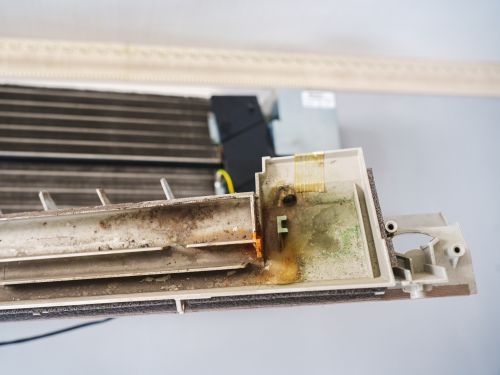Protecting Your Home from Mold in the HVAC System
Mold growth inside your heating, ventilation, and air conditioning system can pose serious health risks and negatively impact your home’s indoor air quality. Because HVAC systems circulate air throughout the entire home, any mold that develops in the air ducts, coils, or air handler can spread quickly. Identifying the signs of mold early is essential for protecting your health, improving your air quality, and preventing costly repairs.
We explain how to detect mold, why it forms, and what steps homeowners should take when mold in the HVAC system is suspected.


Concerned About Mold in Your Homes HVAC System?
Why Does Mold Grows in HVAC Systems?
HVAC systems provide the perfect environment for mold growth: moisture, warm temperatures, and a consistent airflow. Condensation often forms inside air ducts and around evaporator coils, especially if the system isn’t draining properly. Dust and debris inside the ducts act as a food source, allowing mold spores to multiply rapidly.
Clogged air filters, dirty coils, and poor ventilation all increase the chances of mold growth. Because mold spores are microscopic and spread quickly through air currents, a small issue can become a widespread problem if not addressed promptly.
Common Signs of Mold in Your HVAC System
Recognizing the signs of mold in your HVAC system is key to preventing serious health and structural problems. Below are the most common indicators:
Musty or Moldy Odors
A persistent musty smell coming from vents is one of the earliest warning signs. When the HVAC system turns on, it can push mold odors throughout the home. If you notice strong, unpleasant smells that worsen when the air conditioner or heater runs, mold may be present in the ductwork or air handler.
Visible Mold Growth
Sometimes mold can be seen around vents, grilles, drip pans, or inside the air handler. Mold may appear as black, green, white, or brown spots. Even small patches should be taken seriously, as visible mold usually means more is hidden inside the system.
Excess Moisture or Water Leaks
Water around the indoor unit, clogged condensate drain lines, or high humidity levels inside the home can contribute to mold growth. If you notice dampness or moisture inside or around your HVAC equipment, mold is more likely to develop.
Dusty or Dirty Air Ducts
An excessive amount of dust or debris coming from your vents may indicate mold mixed in with airborne particles. While dust alone doesn’t confirm mold, it contributes to the problem by providing a food source for mold colonies.
Increased Allergies or Respiratory Issues
Mold spores circulating through the HVAC system can cause:
- Sneezing
- Coughing
- Itchy or watery eyes
- Headaches
- Asthma flare-ups
If you or your family experience sudden allergy-like symptoms—especially when the system is running—it may be due to mold contamination.
How Mold Affects Indoor Air Quality
Mold in the HVAC system can seriously degrade your indoor air quality. As mold spores circulate, they can trigger allergies, irritate the lungs, and cause respiratory infections. Homes with moldy HVAC systems may feel stuffy, humid, or uncomfortable. Over time, chronic exposure to airborne mold can worsen asthma, weaken the immune system, and contribute to long-term health issues.
From an energy standpoint, mold buildup in ducts and coils can restrict airflow, causing your HVAC system to work harder. This reduces efficiency, increases utility bills, and can shorten the lifespan of your equipment.
What to Do If You Suspect Mold in Your HVAC System
If you believe mold is present in your system, taking prompt action is essential:
1.) Turn Off the HVAC System
Running the system may spread mold spores throughout the home. Shut it down until a professional inspection can be completed.
2.) Schedule a Professional HVAC Inspection
A trained HVAC technician can inspect ducts, coils, and air handlers for mold, moisture, and airflow issues. They can also perform air quality testing to confirm contamination.
3.) Have Mold Removed Professionally
Professional HVAC mold remediation includes cleaning the ducts, sanitizing components, and treating areas with antimicrobial solutions. DIY mold removal is not recommended, as it often spreads spores and fails to address hidden growth.
4.) Repair Underlying Issues
Fixing moisture problems—such as clogged drain lines, poor insulation, or duct leaks—prevents mold from returning. Replacing old or dirty air filters also improves airflow and reduces future contamination.
5.) Consider Preventive Maintenance Plans
Routine HVAC maintenance helps reduce moisture buildup, keeps components clean, and ensures your system operates efficiently.
Protect Your Home’s Air Quality—Schedule an HVAC Mold Inspection Today
Mold in your HVAC system is a serious issue that can impact your health, comfort, and the efficiency of your heating and cooling equipment. If you notice musty odors, increased allergies, or visible mold around vents, don’t wait. Taking action now can prevent costly repairs and keep your family safe.
Contact Better Air Northwest today to schedule a comprehensive inspection and ensure your home’s air remains clean, healthy, and mold-free.

